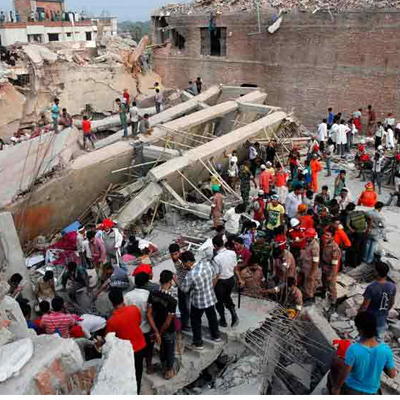 The April 2013 collapse of the Rana Plaza. AFP
The April 2013 collapse of the Rana Plaza. AFP
Undaunted by a run of horrific factory accidents that have hit Bangladesh's garments industry, two entrepreneurs bought Adorn Knitwear Ltd earlier this year. It is a small business not far from the rubble of Rana Plaza, a Dhaka suburb building that collapsed in April 2013 killing more than 1,100 people, most low-paid seamstresses, and prompting a costly safety overhaul at plants large and small. Whether people like Rezaul Karim Chowdhury, one of Adorn's new owners, can afford those improvements will be critical for the future of a sector that accounts for over 80% of this South Asian nation's export earnings, industry leaders say.
Last month, Adorn's production lines were silent and its sewing machines gathering dust as the lengthy process of checking the building for structural weakness was underway. "We're losing money every minute," said Chowdhury, 35, as he looked around his factory, which has a list of potentially expensive fixes to be completed before reopening.
Many high-volume factories depend on smaller firms, contracting out work to meet orders from big Western retailers under tight deadlines. Today, up to 20% of the 3,500 exporting garment factories subcontract, says the Bangladesh Garment Manufacturers and Exporters Association (BGMEA). If that support system crumbles, some factory owners worry Bangladesh's $24 billion industry could lose the agility that took it to number two in the global league of garment exporters.
Since Rana Plaza, nearly two-thirds of the country's exporting garment factories have been inspected. Many have been handed lists of structural, electrical and fire safety fixes and upgrades that could cost hundreds of millions of dollars. Larger factories can generally pay for those changes independently, or have access to a growing number of affordable financing arrangements backed by wealthy customers. Hundreds of smaller factories do not, leaving them exposed at a time when owners say they are grappling with a slide in orders and an increase in minimum wages for the industry's workforce of more than 4 million. Already about 450 factories have gone to the wall since last year's disaster, the BGMEA says.
"If all the factories are becoming big, who will do the smaller things?" said Anwar-ul Alam Chowdhury, chairman of Evince Group and a former BGMEA president. "Then who will come to Bangladesh?"
A Stitch in Time
At Adorn, labourers ripped up flooring to expose steel rods that needed testing. Above them, the word "crack" was spray-painted in red in three spots, all to be analysed by engineers in a weeks-long assessment. Getting factories up to speed after inspections may cost owners from $100,000 to $1 million apiece, according to the World Bank's International Finance Corporation (IFC).
The Accord on Fire and Building Safety in Bangladesh and the Alliance for Bangladesh Worker Safety, brand-backed initiatives that have inspected some 1,700 factories, offer mechanisms through which members are helping suppliers compensate workers for lost wages due to closures and finance factory revamps. Several major apparel firms belonging to the Alliance or the Accord said they had made significant investments to help suppliers improve safety. Not all factories have needed outside funding.
The US-based VF Corporation, an Alliance member whose brands include The North Face and Wrangler, announced it would guarantee up to $10 million for the IFC and Bangladesh's BRAC bank to lend its suppliers. So far, three VF supplier factories have received $1.3 million in loans. The IFC is in talks to do the same with several more Accord and Alliance brands.
"Natural Correction"
Even with more help coming, there are fewer options for the exporting factories that do not sell to Accord or Alliance companies. According to the International Labour Organization, they number roughly 1,800. The BGMEA says it has asked the government to help these factories get up to speed by setting up a fund offering them low-cost loans, but the government says it is up to owners to find a way to meet safety standards after inspections.
"It will be the responsibility of the owner to pay, or he'll have to close it," said Mikail Shipar, secretary of the Ministry of Labour and Employment. Some suppliers may be too unhealthy to secure another bank loan to stay afloat", said Ian Spaulding, senior adviser to the Alliance. "It's going to happen throughout the market, and that's a natural correction that needs to happen."
Saving smaller factories is crucial for the local industry to keep its edge, but also for the economy, said Mohammad A. Rumi Ali, a director at BRAC Bank. "If 75,000 people lose their jobs, and the majority are women, it's a big cost," he said.
Down a dirt road clogged with bicycle rickshaws in Badda, a congested area on the edge of Dhaka, a small garment factory is squeezed into a row of buildings. The owner, who requested anonymity, said he could not meet all the inspectors' requirements, primarily because his business is in a rented building and the landlord refuses to help. "I can't do all of it," he said. "Lower-class factories aren't getting any help."

No comments :
Post a Comment